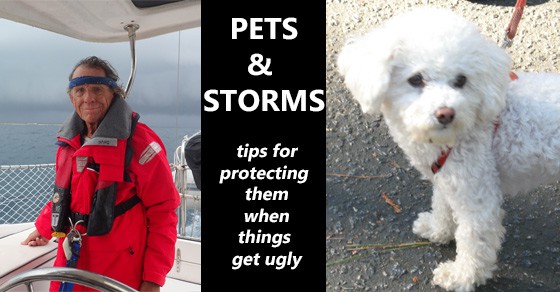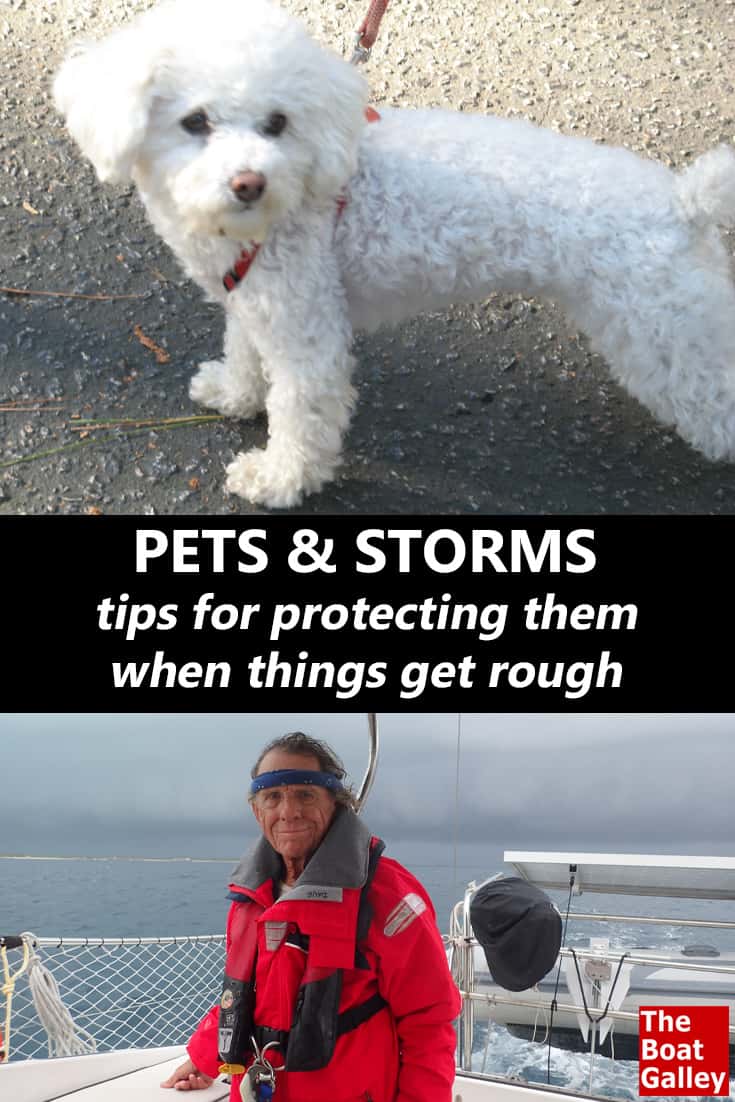I’ve written a fair amount about weathering tropical storms and hurricanes; now, it’s time to talk about pets and storms on your boat. And the best ways to keep them (and you) happy and safe.
To devise the best strategy for keeping dogs and cats (or other pets) safe on a boat in rough seas, ask yourself three questions:
- Will your pets distract you?
- What will keep them safe?
- What will keep them comfortable?
Here are my best tips for answering all these questions.
Keeping Your Pets From Distracting You in a Storm
If a storm arises while you’re underway, the last thing you need is a dog begging for attention or your cat crawling underfoot. Even at anchor, you may need to move away from a developing issue. If minutes count, you don’t want dealing with your pet to distract you from taking action to save your boat.
Check Weather Reports with Pets in Mind
You are checking weather frequently on your boat, right? Even when you’re in a slip, on a mooring, or anchored? Good. Now factor your pets into the information you get. Think ahead about taking them to shore ahead of bad weather. If they’re subject to seasickness, you may want to feed them a smaller meal. Or if your vet has prescribed anti-nausea medications, you’ll need to give them before things get rough. If you have thought ahead, your pet is less likely to bother you when you need to concentrate on boat tasks.
Secure Them Away From the Cockpit
You’ll want to find a secure spot for your pets during a storm. And sending them to this safe place will help you focus on other matters, like avoiding an accidental gybe, prepping or worsening conditions, or avoiding trouble in a tricky approach.
Pets who spend every moment by your side may resist being out of your presence. So this is something you’ll want to practice before you need it. An easy way to train it is to provide particularly yummy treats or a favorite toy–but only when they’re in their special spot. Eventually they’ll love it, even if you’re not right by their side.
Remember, keeping pets away from the action is ultimately for their own protection. It’s far too easy to injure a small pet if you accidentally step on them while you’re concentrating on something else.
Once they’re out of your way, there are a few other considerations for pets and storms on your boat.
How to Keep Pets Safe on your Boat in a Storm
The designated spot to keep your pet from distracting you should also be a safe place for them to wait out a storm. Make sure it’s snug enough that they don’t go rolling around. If it’s on the floor, Of course, watch out for stuff stacked on tables and settees — even temporarily. Even light items that slide off could cause injury or startle your pet if the boat rolls. A 10-pound dog or cat is no match for a book that falls, much less a sail stowed below!
If you’re planning to stay aboard, make sure you have supplies for the pet in your ditch bag. Just as you need to have any daily medications for yourself accessible, make sure any for your pet are where you can get to them.
Perhaps the safest option is to go ashore.
Leaving the Boat
If you are going to be ashore during the storm, take your pet with you (you know this because you checked the weather first, right?). Make sure your pet is welcome or make alternative arrangements. If it’s not safe for you to be aboard during the storm, why should your pet stay there? They are even less able to help themselves if something goes wrong.
Does your cat like to hide? Find him or her well before the storm hits and put them in their carrier. That way you’ll be able to take them when/if you leave (yes, it’s possible that conditions will force you to leave when you didn’t plan to . . . and you wouldn’t want to leave your best friend behind).
For dogs, make sure that their life jacket is readily at hand. Ditto for the leash. A harness is much better than just a collar in bad weather.
If you’re planning to go ashore “for the duration,” be sure to take food, water and dishes for your pet.
Finally, protecting your pet is not only about safety. You also want to make sure they are comfortable and not traumatized by conditions.
Keeping Pets Happy in a Storm
If you don’t already know the best seasickness preventive for your pet, find out from your vet and have the supplies on hand. Check with your vet, but it’s generally better to give them early than wait until the pet is sick. If they become dehydrated from sickness, use the same rehydration drink or Gatorade that you’d take.
Even a mild sedative can help. Pets can take some (but not all) human OTC allergy medications that have a mild sedative effect. Check with your vet about which ones are safe and the proper dosage for your pet.
Some pets benefit from a distraction in bad weather. If you have crew available, have someone help your pet. Some prefer cuddles. Others like to chew or play tug when they feel stressed. Churu cat treats (Amazon) are popular with both dogs and cats. They keep for a long time unopened. And the licking action is calming for pets.
Some dogs enjoy trick training to keep them from focusing on conditions. Teaching “high five” or to boop you with their nose on cue are fun diversions for smart pups who love to learn.
Managing Pets and Storms on Your Boat
When we crossed the bar into Bahia del Sol, El Salvador, we surfed (!) a very heavy Tayana 37 through the breaking seas. A few days before, a couple of other boats had broached going through. To make sure that Paz — then weighing only 5 pounds — stayed safe while we were both on deck. Dave steered; I was on the radio. We taped thick towels around every protrusion in the head, then piled all our pillows on the floor in there. It was the smallest enclosed area we had on the boat. We put Paz in there in her life jacket (as padding, not that we thought the boat would go down) and shut the door. She barked, but we knew she was safe (we didn’t broach or have any other problems).
If we had thought about it ahead of time, we might have worked to help her feel more comfortable alone in the space. But at least we knew she was not distracting us, safe, and as comfortable as we could make her.
Every boat, every situation and every pet is different. But don’t forget to plan for your furry friends — they can’t do it for themselves. And remember, you aren’t on your own. Fellow cruisers with pets will have great suggestions. We developed the Cruising with Your Dog course chock full of advice from someone who cruised with a large dog for eight years. This unique course becomes even more of a bargain when you take advantage of our All-Access Pass to all our cruising courses.
Just remember, your pets bring you hours of love, companionship, and entertainment. A little preparation and thought will go a long way to keeping them happy even in storms.
Related Posts
Learn clear, actionable steps to plan ahead and protect your boat with confidence this hurricane season.
Get Hurricane Ready

Carolyn Shearlock has lived aboard full-time for 17 years, splitting her time between a Tayana 37 monohull and a Gemini 105 catamaran. She’s cruised over 14,000 miles, from Pacific Mexico and Central America to Florida and the Bahamas, gaining firsthand experience with the joys and challenges of life on the water.
Through The Boat Galley, Carolyn has helped thousands of people explore, prepare for, and enjoy life afloat. She shares her expertise as an instructor at Cruisers University, in leading boating publications, and through her bestselling book, The Boat Galley Cookbook. She is passionate about helping others embark on their liveaboard journey—making life on the water simpler, safer, and more enjoyable.





Bailey Boat Cat on Facebook says
WOW! Thank you for the great tips and advice! I will get my crew to read this. I just realised you live on a tayana 37 like me! I love our Nocturne she makes me feel very safe.
The Boat Galley on Facebook says
Hey Bailey! Do you have any tips that people with boat cats should know? Where’s your favorite place when the boat gets rocking & rolling?
John says
Just a couple of things we’ve done to keep our Brit Spaniel, Becky, safe on board in rough weather or when cruising:
1. netting on our lifelines (dogs can’t grab handholds!)
2. A tight-fitting nylon harness that goes around and under the chest. The harness has a large D-ring/strap sewn on top for grabbing and also a water-activated small personal strobe light also sewn on top in case she goes overboard at night
3. A short tether line with snap shackle at both ends is also attached to the chest harness. When our sea-dog has to do her business up front on the artificial grass, we just clip her into the jack-lines running along the side-decks, tell her “go pee” and up she goes and back again afterwards all on her own. This shackle system works even in rough weather
4 for what it is worth, our dog is happier in rough weather if she can be top-side and can see what is going on. If down below in rough seas she seems more bothered by the clanking, banging etc
5. We also have pad-eyes in the cockpit where we also sometime clip her in on her tether-harness
6. When docking, or crossing a bar or anytime when things might get exciting on short notice we as a rule don’t want to have to worry about her or her getting underfoot so she gets shut down below
7. We found that on-board we struggled with the problem of keeping her hydrated while not continually knocking over or spilling her water-bowl. The perfect solution is a “WATER-HOLE BOWL” which is a travel waterbowl which comes with a partial lid which stops most spills but still let’s the pet drink. We also use this bowl when traveling long distances in the car (as in driving to Mexico from Calgary, Alberta)
8.only problem we haven’t yet solved is how to deal with the Mexican and Central American crocodiles that are always hanging around near our boat in Marinas looking for a tasty ‘hot dog’
Anyhow that’s what we do – might be of some help to other sea-dog owners — we enjoy your website
Fair Winds
John (Wannabesailing)
MOPION
Gozzard 36
Bailey Boat Cat on Facebook says
I’m still learning and preparing to go cruising! We are experimenting with alternatives to cat litter atm because this is the biggest problem. (Along with the moans about my uhum…furloss!) I like to tuck myself in to the smallest possible place when we get underway. I’m not too fussy as long as I can brace myself against something.
Vicki Telesford says
I have heard that artificial grass works well for cats too. Use a bit cut to size in their tray, gradually reduce the litter on top of it until they get used to just using grass. To be graphic…once you are on just grass flush the poos as soon as possible after they appear, the grass can be rinsed overboard if you thread a line through for the job. Apparently it works well and save the bulky messy nightmare of litter. We start training our cat ready for liveaboard in a week or two…..I will let you know if we succeed!
Carolyn L says
Wonder if this worked out? Moving our cat aboard soon, would be good to know.
Heather Hill says
Just got my cookbook in the mail today! So excited to start learning how to cook in a Thermos and make Yogurt.
The Boat Galley says
Great!
The Jedi Fisherman says
😀
The Jedi Fisherman says
Cool really great more on please
The Boat Galley says
I have quite a bit both on dogs and on storm prep! For dogs, start here: https://theboatgalley.com/cruising-dog/ For storm prep, start here: https://theboatgalley.com/hurricane-preparation/